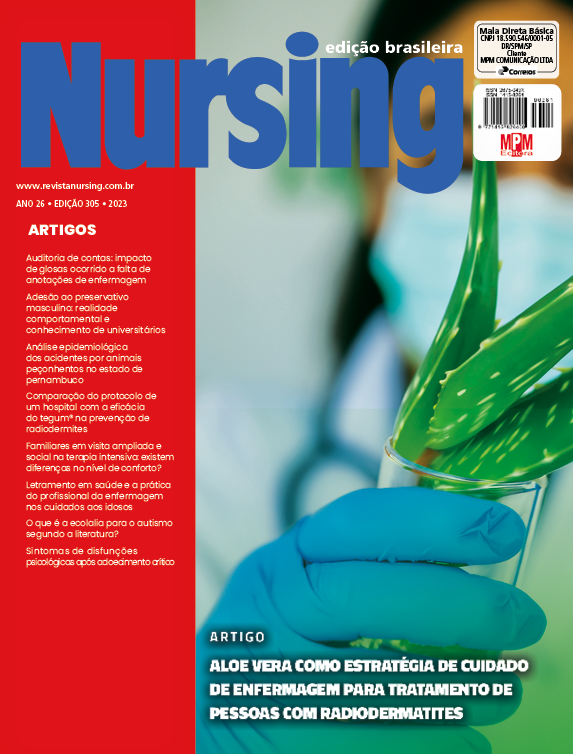PSYCHOLOGICAL DYSFUNCTION AFTER CRITICAL ILLNESS
DOI:
https://doi.org/10.36489/nursing.2023v26i305p10000-10004Keywords:
Critical care outcomes; Intensive care units; Anxiety; DepressionAbstract
Objective: To estimate the prevalence and identify factors associated with symptoms of anxiety and/or depression. Method: Cross-sectional study carried out in a large hospital. Data was collected using a sociodemographic and clinical form and scales to screen for symptoms of anxiety and depression. Descriptive statistics and a regression model were used in the analysis. Results: 83 patients were included, mostly men, with an average age of 47, brown, with a low level of education, married, Catholic and with a monthly income of less than one minimum wage. 36.3% had symptoms of anxiety, 29.5% of depression and 21% of both. Male gender and younger age were associated as protective factors for the development of psychological symptoms. Conclusion: People undergoing intensive care face psychological dysfunction after discharge, so it is pertinent to implement care measures and public policies to deal with this damage.
References
Golinelli PC, Viana RAPP. Unidade de Terapia Intensiva: planta física, organização e administração de recursos humanos e materiais. In: VIANA RAPP, TORRE M, organizadores. Enfermagem em Terapia Intensiva: práticas integrativas. Brasil: Manole; 2017. p. 2-9.
Needham DM, Davidson J, Cohen H, Hopkins RO, Weinert C, Wunsch H, et al. Improving long-term outcomes after discharge from intensive care unit: Report from a stakeholders’ conference*. Critical Care Medicine. 2012; 40 (2): 502–509. Disponível em: https://journals.lww.com/ccmjournal/Abstract/2012/02000/Improving_long_term_outcomes_after_discharge_from.20.aspx. Acesso em: 8 abr. 2022.
Yuan C, Timmins F, Thompson DR. Post-intensive care syndrome: a concept analysis. International journal of nursing studies. 2021 ;114: 103814 Disponível em: https://doi.org/10.1016/j.ijnurstu.2020.103814. Acesso em: 23 abril.
Tejero-Aranguren J, Martin RGM, Poyatos-Aguilera ME, Morales-Galindo I, Cobos-Vargas A, Colmenero M. Incidência e fatores de risco associados à síndrome pós-cuidados intensivos em uma coorte de pacientes em estado crítico. Revista Brasileira de Terapia Intensiva. 2022; 34: 380-385. Disponível em: https://www.scielo.br/j/rbti/a/FtB6FDYbNCZds3LYxRc7QQJ/abstract/?lang=pt. Acesso em: 23 maio 2023.
Prince E, Gerstenblith TA, Davydow D, Bienvenu OJ. Psychiatric Morbidity After Critical Illness. Critical Care Clinics, 2018; 34: 599–608. Disponível em: 10.1016/j.ccc.2018.06.006. Acesso em: 11 nov. 2021.
Calsavara AJ, Costa PA, Nobre V, Teixeira AL. Prevalence and risk factors for post-traumatic stress, anxiety, and depression in sepsis survivors after ICU discharge. Brazilian Journal of Psychiatry. 2020; 43: 269–276. Disponível em: http://www.scielo.br/j/rbp/a/HHLCcD8XzVpkQLjWDCnWqWq/. Acesso em: 19 maio. 2022.
American Psychiatric Association (APA). DSM-5: Manual diagnóstico e estatístico de transtornos mentais. Artmed Editora, 2014.
Spitzer RL, Kroenke K, Williams JBW, Löwe B. A brief measure for assessing generalized anxiety disorder: the GAD-7. Archives of internal medicine. 2020; 10: 1092-1097. Disponível em: https://scholar.google.com/scholar_url?url=https://jamanetwork.com/journals/jamainternalmedicine/article-abstract/410326&hl=pt-BR&sa=T&oi=gsb&ct=res&cd=0&d=3790605624533378432&ei=OyEYYYH_AceSy9YPromUwAk&scisig=AAGBfm0Lgg7qVazdLWSE6Ql4dWBmxTua8A. Acesso em: 30 set. 2020
Kroenke K, Spitzer RL, Williams JBW. An ultra-brief screening scale for anxiety and depression: the PHQ–4. The PHQ‐9: validity of a brief depression severity measure. Journal of general internal medicine. 2001; 16 (9): 606-613. Disponível em: https://onlinelibrary.wiley.com/doi/full/10.1046/j.1525-1497.2001.016009606.x. Acesso em: 18 maio 2022.
Rosa RG, Ferreira GE, Viola TW, Robinson CC, Kochhann R, Berto PP, et al. Effects of post-ICU follow-up on subject outcomes: A systematic review and meta-analysis. Journal of Critical Care. 2019; 52: 115–125. Disponível em: https://linkinghub.elsevier.com/retrieve/pii/S0883-9441(19)30301-6. Acesso em: 29 maio 2022.
Rousseau A, Prescott HC , Brett SJ , Weiss B, Azoulay E, Creteur J, et al. Long-term outcomes after critical illness: recent insights. Critical Care. 2021; 25(1): 108. Disponível em: https://doi.org/10.1186/s13054-021-03535-3. Acesso em: 8 abr. 2022.
Karnatovskaia LV, Schulte PJ, Philbrick KL, Johnson MM, Anderson BK, Gajic O, et al. Psychocognitive sequelae of critical illness and correlation with 3 months follow up. Journal of Critical Care. 2019; 52: 166–171. Disponível em: https://linkinghub.elsevier.com/retrieve/pii/S0883-9441(19)30182-0. Acesso em: 15 maio 2022.
Sevin CM, Bloom SL, Jackson JC, Wang L, Ely EW, Stollings JL. Comprehensive care of ICU survivors: Development and implementation of an ICU recovery center. Journal of Critical Care. 2018; 46:141–148. Disponível em: https://www.ncbi.nlm.nih.gov/pmc/articles/pmid/29929705/. Acesso em: 3 maio 2022.
Unoki T, Sakuramoto H, Uemura S, Tsujimoto T, Yamaguchi T, Shiba Y, et al. Prevalence of and risk factors for post-intensive care syndrome: Multicenter study of patients living at home after treatment in 12 Japanese intensive care units, SMAP-HoPe study. PLOS ONE. 2021; 16 (5): e0252167. Disponível em: https://journals.plos.org/plosone/article?id=10.1371/journal.pone. 0252167. Acesso em: 22 fev. 2022.
Vlake JH, Wesselius S, Genderen ME, Bommel J, Klerk BB, Wils E. Psychological distress and health-related quality of life in patients after hospitalization during the COVID-19 pandemic: A single-center, observational study. PLOS ONE. 2021; 16 (8): e0255774. Disponível em: https://journals.plos.org/plosone/article?id=10.1371/journal.pone.0255774. Acesso em: 22 fev. 2022.
Kawakami D, Fujitani S, Morimoto T, Dote H, Takita M, Takaba A, et al. Prevalence of post-intensive care syndrome among Japanese intensive care unit patients: a prospective, multicenter, observational J-PICS study. Critical Care. 2021; 25 (1): 69. Disponível em: https://www.ncbi.nlm.nih.gov/pmc/articles/pmid/33593406/. Acesso em: 18 abr. 2022.
Kosilek RP, Schmidt K, Baumeister SE, Gensichen J, Smooth Atudy Group. Frequency and risk factors of post-intensive care syndrome components in a multicenter randomized controlled trial of German sepsis survivors. Journal of Critical Care, 2021; 65: 268–273. Disponível em: 10.1016/j.jcrc.2021.07.006. Acesso em: 22 jun. 2022.
Lopes CR, Iepsen LB, Costa, J. B. Avaliação psicológica de pacientes após a alta da unidade de terapia intensiva. Psico. 202; 51 (2): e33640-e33640. Disponível em: http://dx.doi.org/10.15448/1980-8623.2020.2.33640. Acesso em: 18 abril 2023.
Tripathy S, Acharya SP, Singh S, Patra S, Mishra BR, Kar N. Post traumatic stress symptoms, anxiety, and depression in patients after intensive care unit discharge - a longitudinal cohort study from a LMIC tertiary care centre. BMC psychiatry. 2020; 20 (1): 220. Disponível em: 10.1186/s12888-020-02632-x. Acesso em: 9 jul. 2022.
Demoro G, Damico V, Murano L, Bolgeo T, D'Alessandro A, Molin AD. Long-term consequences in survivors of critical illness. Analysis of incidence and risk factors. Ann Ist Super Sanita; 2020; 56 (1): 59-65. Disponível em: https://dx.doi.org/10.4415/ANN_20_01_09. Acesso em: 10 ago. 2022.








